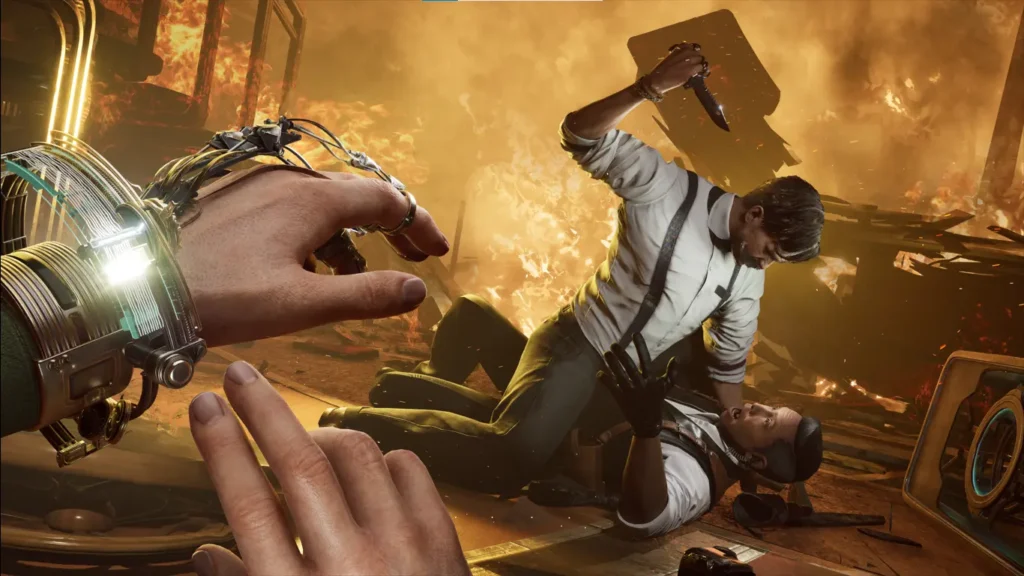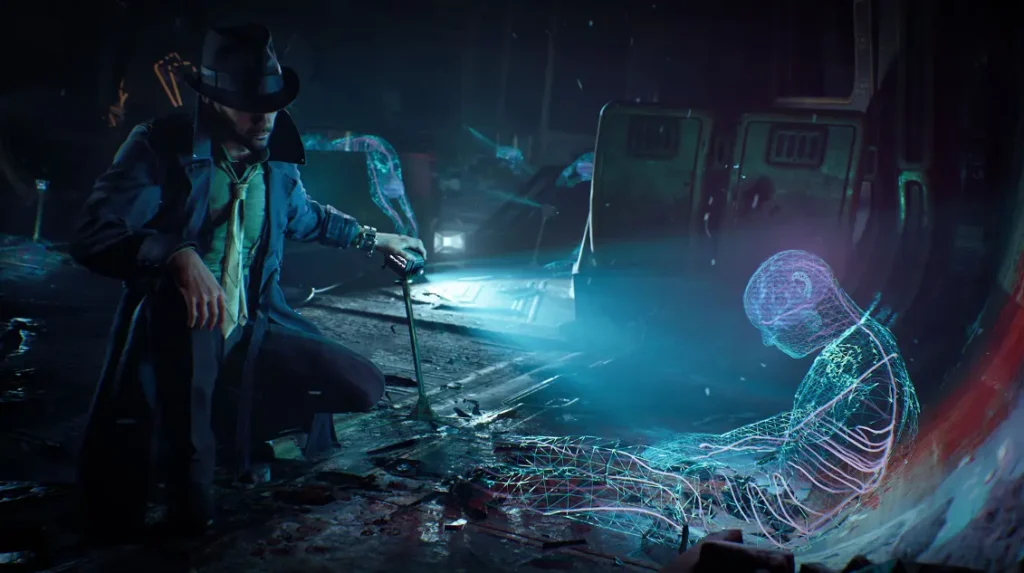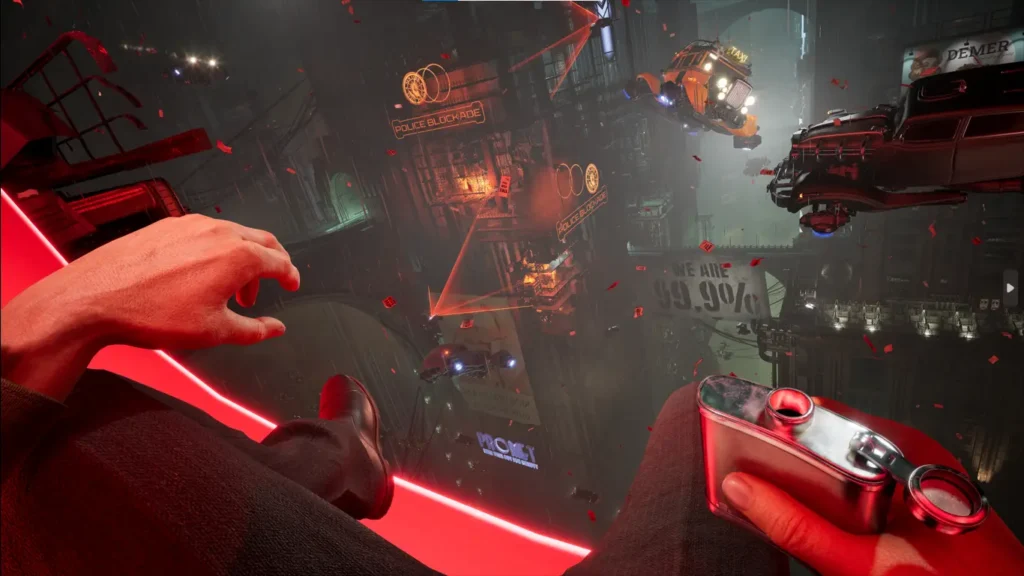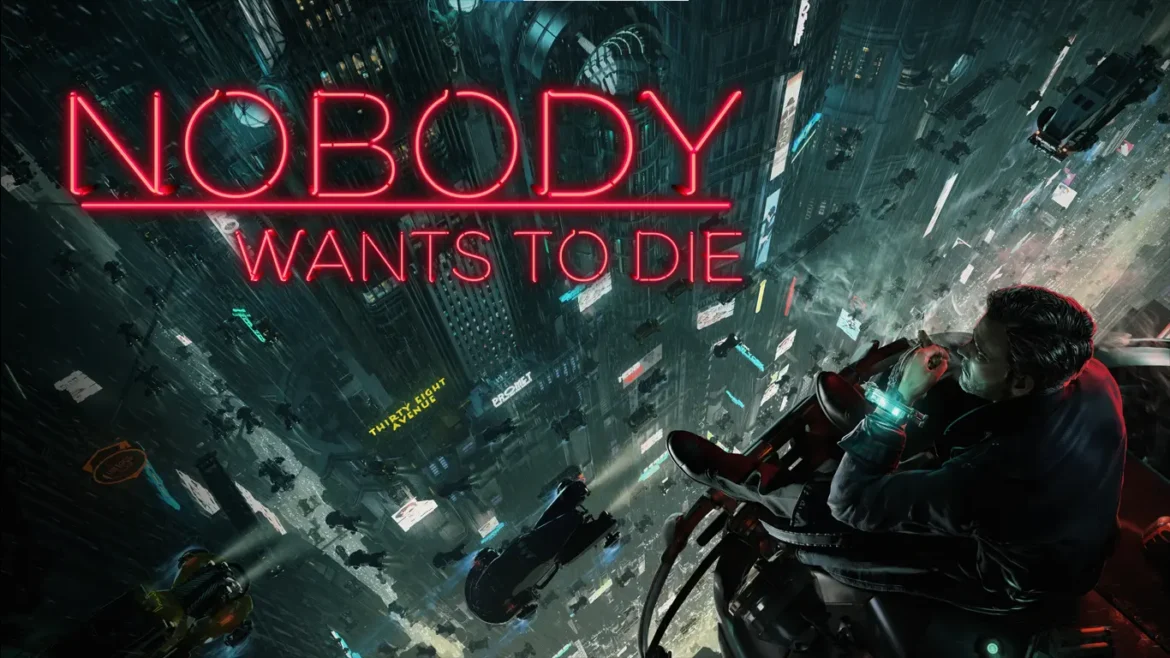Release Date : July 17, 2024
Developer(s) : Critical Hit Games
Publisher(s) : PLAION
Platforms : PS5, Xbox Series X/S, PC
It’s an understatement to say that cyberpunk and film noir fit well together, and can easily arouse fascination. There’s something deeply human about projects using these two genres, addressing intimacy, loneliness and the discomfort of individuals in a society they no longer understand, or no longer accept. While literature gave birth to the above-mentioned genres, it was the evocative power of cinematic images that sealed the collective imagination.
Nobody Wants to Die, from the Polish studio Critical Hit Games, is one of these influences, and obviously has a familiar aesthetic, inspired by Ridley Scott’s Blade Runner as well as certain noir thrillers. And despite the fact that it’s the first production from a little-known studio, the rendering of the Unreal Engine 5 was impressive during the presentation trailers.
Table of Contents
Nobody’s Dying

When death is no longer a destiny, a whole society is transformed. A retro-futuristic dystopia drawing heavily on cinema and video games – some of the influences are a little too explicit to ignore – Nobody Wants to Die aims to give us an experience both immersive and exciting. After a somewhat vague, explanatory introduction, a seamless tracking shot that Brian De Palma would not have disliked reveals the interior of a vehicle.
No Philippe Marlowe here, but detective James Karra. Disillusioned as much as an alcoholic, our hero takes a moment to watch a film in a kind of drive-in, the open-air cinemas made popular in the 40s where you watch a movie from your car, but with the 2329 sauce, flying vehicles, and non-existent roads like in The Fifth Element. Without giving too much away, this introduction is a real eye-opener.
The dialogue is also top-notch, whether for the detective or our colleague, or the voice in the earpiece, Sara. Supported by great writing, listening to their conversations throughout the adventure is a treat. Especially since Nobody Wants to Die knows how to break the tone, with humor cleverly finding its place despite the darkness of the world and the seriousness of the stakes.
In just a few minutes, we’re caught up and thrown into this fascinating retro-futuristic New York. The beauty of the environments commands respect. The city feels so real, and so dizzy. Critical Hit Games have done a brilliant job, making the most of Unreal Engine 5. Of course, the game is not immune to glitches, some blurring and display issues, not to mention a few unconvincing textures, but apart from the graphics buffs, there’s nothing to spoil the immersion.
Broken Reality

Having said that, Nobody Wants to Die has some immersion difficulties. Awkward, and avoidable ones too. The atmosphere is real, and keeps you on your toes without letting go too much, except when the game decides to. The structure of the game divides the adventure into “levels” separated by a significant break. A detail for some, a problem for others, since it obviously breaks up a relatively short experience – too short for our liking, but we’ll come back to this later – forcing us to leave this universe for a short time. A way of managing ellipses that deserved better.
The constant presence of on-screen indications is not very engaging, given that making this possible was within easy reach. The box displaying the current objective is a good example, which could be bypassed by an object or tool possessed by the hero. In the same vein, during the investigation phases, when you have to search for clues in a crime scene, an object’s action button will always be displayed. There is no option to deactivate this.

The perfect transition to gameplay. Nobody Wants to Die is mainly built around its investigations. Despite their deceptive simplicity and the fact that the game is constantly holding us by the hand, which can spoil the fun, these sequences are cool. Because everything happens inside the scenes and revolves around the technological bracelet worn by the detective.
This bracelet is used to manage the passage of time and reconstruct events. It’s an amusing mechanism that allows us to view these scenes in a stylish way. Each “level” will present us with a crime to solve, before we have to switch to another gameplay, based on gathering clues. In other words, it’s like a board game, with pieces representing the clues and information collected, which you have to move around so that they correspond to the theories suggested by James and Sara.
Body Double

Again, the limited number of investigations, hence game situations, prevents any redundancy or heaviness. In fact, it’s quite fun to play, even if you can’t fail and you have to remember a lot of information and names in a short period of time. There’s no menu to refresh your memory. Fortunately, there’s nothing too difficult.
The rest of the time, Nobody Wants to Die follows its storyline, leaving brief moments of freedom for the player. It’s similar to Walking Simulator, but with a limited surface area. Whether in terms of the number of environments or locations traversed, the freedom offered quickly reaches its limits. And that’s a pity, because this is where we saw the best of what the game has to offer.

Ideas for narration and staging that hit the nail on the head, like the mental boxing match with a neighbor, the solitary reflections soaked in cigarette fumes, while we’re invited to contemplate the immensity of the city. However, sometimes the developers overlook the staging. It’s quite common to be inactive during a discussion, which is frustrating considering what Nobody Wants to Die can offer when it wants to.
Or perhaps the teams at Critical Hit Games didn’t dare to push their ideas to the limit. What emerges in the quiet situations, when the game lets us lose ourselves in James Karra’s head, remains strong and, in our opinion, Nobody Wants to Die would have benefited from losing itself in these portions of the game. Especially as the story concludes too quickly and suddenly. Beyond the three endings we’ve already seen, it’s the speed with which the credits roll that’s particularly disappointing.
Fallen Angel

Reading all the documents, and experiencing each dialogue through the game’s choices, the impact remains minor and only makes a real turn at the end, doesn’t give us all the keys we need to fully understand this society. This approach was used in Blade Runner, but in the context of a video game, we were entitled to expect more. Particularly in a narrative game, where taking your time isn’t a bad idea.
As a result, we’re left with the impression that we’ve missed out on a great deal, that we can’t take full advantage of an exciting universe. Even though some of the ideas seem to be straight out of the Altered Carbon novels, this doesn’t detract from the relevance of the themes addressed. The question of life and death, of course, but also subtle questions about loneliness and social relations with exchangeable bodies.

Not to mention the whole political and economic dimension. And loneliness, always the loneliness, the shadow hovering over everyone. Suffocating like the endless buildings. We’re talking about a New York where heaven and earth are no longer visible, and nature seems non-existent. Nobody Wants to Die portrays a society in which those who overcome death do not necessarily become alive again. The city is full of life, yet in James Karra’s shoes, we come across more corpses than living people.
In Nobody Wants to Die, people are no more than voices in the background, corpses are resurrected by the glow of technology, and detective Karra lives only through the ghosts of the past, who come to haunt him and dance to the omnipresent dark, sometimes jazzy sounds. Mikolai Stroinski, known for his work on The Witcher 3: Wild Hunt, plays his part perfectly, creating a result totally in tune with his subject. All the darkness and fatality that run through this New York of 2329 are played out here.
Conclusion
Nobody Wants to Die is a highly enjoyable experience, especially for a first release. The studio wanted to deliver an immersive, well-written work, and the gamble paid off. Without being overly original – the references are too explicit for that – the game attracts us with its magnificent retro-futuristic universe, before grabbing us with a pair of finely written and interpreted characters. The few gameplay sequences have the merit of being enjoyable, particularly the investigation phases, which benefit from the really stylish time bracelet mechanic, although they fail to really engage us due to their simplicity. However, it’s hard to ignore the narrative and staging flaws, the plot that moves too quickly, and the themes that deserve better handling. Overall, this game should please all film noir and cyberpunk fans.
